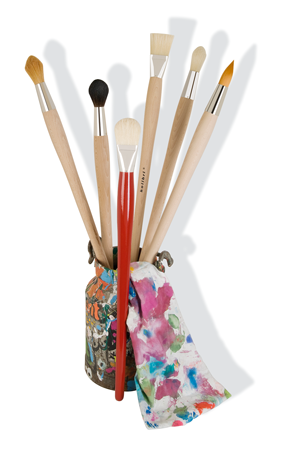
About Hair Brush
It may be interesting to know that the production of hair and bristle brushes in Germany can be traced back to as early the 18th century, with fine brushes been made especially in the Bechhofen and Burk area.
Ever since and up to our present day and time, animal hair imported from various parts of both Europe and Asia, has been and is used for the production of brushes.
The following will give you some more detailed information on the most used types of hair.
Red sable hair:
Red Sable hair comes from the tails of different members of the weasel family. This type of hair is the most elastic hair and it is, therefore, best suited for artists’ brushes. Brushes made from this material are unparalleled for their fineness and durability.
Kolinsky Hair:
Kolinsky is absolutely the best natural hair for artists’ brushes. It comes from the tails of Siberian Kolinsky martens.
Imitation Sable Hair (Sabeline):
The often called Red Sable imitation is made from ox ear hair which is dyed in a color similar to that of red sable hair. Only ox ear hair with the best tips is suited for this purpose.
Ox Ear hair:
Is fine, elastic and with best tips. It is particularly qualified for the production of sign writer-, lining brushes, oil artists’ brights, rounds and flats and last but not least for lacquering brushes.
Fitch hair:
Fitch Hair comes from the Polecat. This hair is black- grayish color and is short in length. Its fineness and elasticity is almost up the quality of red sable hair. Artists’ brushes such as oil painting brushes, china painting brushes and best water color brushes are made from this type of natural hair.
Squirrel:
Squirrel hair comes from the tails of different species of squirrels.
- Hair from the Kasan Squirrel which lives in East Russia is used for brushes that serve for painting on smooth surfaces in the china and glassware industry.
- Talutky squirrel have the longest hair of all squirrels. Their quality matches that of Kasan squirrel hair. Talutky squirrel hair has its special use in the production of writing brushes and liners.
- Hair from Canadian squirrels is generally of short length and of a yellow-blackish color. This hair has particularly fine tips and is used for quality water color brushes.
Pony hair:
Pony hair comes from Japan and China. This hair is available in different shades, from light red to dark brown and black. Although it is equally a soft material, it is not as fine and resilient as squirrel hair. This is why only regular water color brushes are made of this type of material.
Goat hair:
Goat hair comes from China and India. This is grey, brown, black or white in color. Larger sized brushes such as mops and flats and cosmetic brushes are made of goat hair.
(Hog) bristles:
The best qualities come from the highlands in north- Easter part of China. Two characteristics of a quality bristle brush are flagged tips and interlocked construction.
Natural bristle has a split tip called a flag. This flag helps the brush hold maximum paint and acts as an extra “paintbrush” during application. The lack of flags on a bristle brush indicates a brush which has been cut, not hand shaped.
Synthetic hair:
Synthetic hair in thickness of 0.06 – 0.15 mm has been used in recent years with great success. It emerges in an extremely fine point which is almost identical with sable hair. The special features which we are use are the conical shape, the well structured surface which takes over the function of the scales on natural hair and guarantees an even color distribution.
In the last time brushes made of e.g. synthetic Squirrel hair or synthetic Mongoose hair are very similar in quality and characteristics like the origin. And also a good thing- they help to protect the animals worldwide.
“Artificial Bristles”:
Artificial bristles with a diameter of 0.20 mm upwards are fibers which display very good elasticity, an extremely long service life and high level of sharp retention.
They are used primarily in brushes for acrylic painting. The range and the several of qualities of synthetic hair and artificial bristles are very wide. That’s why it is impossible to compare only the price of synthetic brushes.
